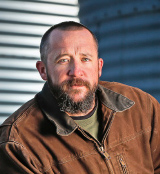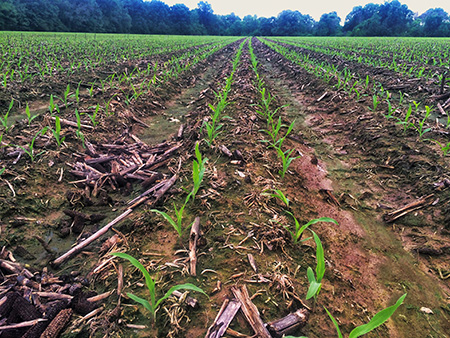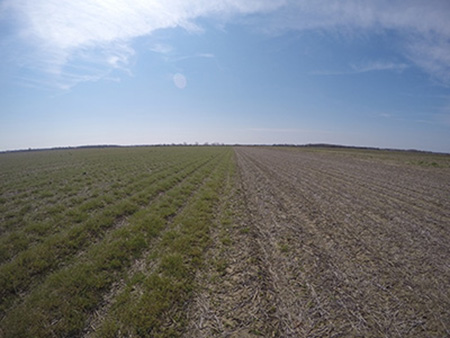This yearlong endeavor looks at how four farmers are evaluating technology and agronomic information that can boost the productivity of their operations.

I almost feel a little bad talking about the stage our crops are in here in the Mid–South. Today is July 31, and we sprayed our first few fields of grain sorghum with glyphosate used as a desiccant for harvest. Our corn is all within two to three weeks of harvest (18% moisture or below for us), and our soybeans are in the late R5 stage. That probably sounds outrageous with all the rain in the Midwest and even as far down as the northern part of my home state, Arkansas.
Coming out of May we had an extremely dry June. Farmers in the area went from trying to work fields dry to having to quit planting because of a lack of moisture two short weeks later. With the exception of a good rain around the first of July, we've been dealing with high humidity and high temperatures. Over the last three weeks, all the daytime highs have been 95 degrees plus. We have only hit 100 a couple of days, but the heat indexes have been in the range of 105 to 120 for almost a month!
We irrigate 100% of every crop we raise, so that has pretty much been the focus of our operation. Our July days start at sun–up riding to each field that is irrigating, checking the diesel power unit or electric motor, walking the miles and miles of poly pipe to make sure we have the proper water pressure, and then trying to drain the fields on the bottom ends. We terminated irrigation on most of our corn and sorghum acres in mid– to late July, so this heat is literally baking the two crops dry. Just this week it seems the predominant color of the corn has gone from green to yellowish brown.
We irrigate our soybeans about every 10 days. Usually we will have one or two more waterings in our corn versus our soybeans, but this is not turning out to be a usual year. Because of the early rain we didn't have to irrigate the corn until around the time it started tasseling. Most of our cornfields ended up with three to four waterings, whereas we're going to have at least five in all our soybean fields. Looking at the forecast for the next couple of weeks, I kind of feel like that number will be at least a six when it's all said and done.
The only other thing that has been in the forefront of our minds is insects. The insect numbers seem to be pretty good in the corn and soybeans so far this year, but I can't say the same for the new kid on the block. The flying services in our area are picking up some good Christmas money, trying to control the bugs in all the grain sorghum acres in the area. Sugar cane aphids have come onto the scene with a vengeance. We've sprayed almost every field we have once, and several of them have been treated twice already. We are using 1 ounce of Transform WG in most cases to get control of the aphids before they cause any serious damage. Between the insecticide cost and the flying, the aphids are adding $15 per acre of expense with every treatment to a crop that we are still unsure of in regard to yield potential. We're even having to run a separate insecticide called Belt to control bollworms that are feeding on the heads when the sorghum is in the grain fill stages in many cases, adding another $5 to $8 to the mix.
We knew this was a possibility at the start. We had hoped with an early planting date, we could outgrow the bugs. Right now, I am not so sure we succeeded. Although, we may have won the battle with the later–planted sorghum just on the number of airplane passes.
Like everything, it is just going to come down to a simple battle for yield on our operation. We had hoped the sorghum would be cheaper enough than corn that it could compete in an income per acre comparison. We felt pretty good about it until the insect invasion in the sorghum. I feel pretty comfortable saying we will harvest 200–plus–bushel corn, but we have not grown enough of the grain sorghum to have much to compare it to. It is going to take some very high–yielding sorghum to offset the amount of bushels on a per–acre comparison with the corn. The sorghum had a nice advantage in the expense category, but every time the plane flies over, it loses a little ground.
Hopefully, the next time you all hear from me, we will be blowing and going in the middle of harvest. By then, I'll have some real figures to use to see if grain sorghum will have earned a spot in the rotation for next season. Prayers for a safe and plentiful harvest!!
It's not important who does the planting, or who does the watering. What's important is that God makes the seed grow. 1 Corinthians 3:7
I want to use my post for this month to do a little recapping of some of the things I have talked about over the last few months. I mean, what good is reading about innovation if it is not accompanied by some real-world results? So, referring back to my last post, roughly one month ago, SOME of the seed is out of the bag. We are 75% planted, emerged, and growing on our corn. We also made the decision to add grain sorghum into our rotation, and we are just shy of 50% planted and emerged on that venture. We had a pretty nice dry spell coming out of March into the first 10 days of April. This allowed us to get everything rolling and stick some seeds in the ground. Now, we are patiently waiting on it to dry up again as I sit on my porch and listen to the raindrops-a not-so-soothing sound. In January, I posted a couple of videos about our new use of cover crops to curb erosion, increase available nitrogen and improve overall health of the soil. Below is a photo from February 12 of the burndown application to the same spot where the video was taken in January.

This application is a tank mixture of 22 ounces of RoundUp Power Max, 2 ounces of Sharpen, and 1% methylated seed oil per acre. You can see how rough the freezing temperatures were to the radishes even before the chemical was applied. One of our primary concerns with the use of cover crops was how well we would be able to plant into the stale beds after burndown. We just weren't sure how much material would be left coming out of winter. Below are pictures of the same area of the field today.


As you can see, our concerns were not warranted. We were able to plant this field on April 8. The coulters on our Great Plains 2025 twin-row planter easily handled what little crop residue was left from the cover crop, and we have a beautiful start to the growing season.
As you can see, we are set up on a twin-row system for all of our row crops. Row spacing seems to be topic that never really dies. I have read several articles about narrow-row corn and soybeans in the Midwest, but row spacings of less than 30 inches are tough to manage where irrigation is a factor. One hundred percent of our farms are row watered with poly tubing. This means that every field is planted on raised beds to aid in drainage and irrigation. My dad and I have played with row spacing over the last 20 years, and we feel we finally landed on a system that really maximizes the balance between drainage and irrigation on our farm.
We establish a 40-inch bed with a Brandt Hipper Chopper (plowed bed). Then, we have our planter set up on 40-inch centers, with 10-inch twin-rows. This still allows for a 30-inch middle between the outside rows of each bed. It gives us optimal spacing for corn and soybeans, letting us push seeding populations on non-flex corn hybrids to as much as 40,000 seeds per acre-thus, maximizing yields on our more productive fields. The wide bed also fits in well with our no-till system by staying in place over the winter without having to be reshaped.
I mentioned the benefits of spacing with a twin-row system in being able to push the upper limits of seeding rates. The same is true for the other side of that coin. On springs where cold temperatures and excess rains make it tough to establish an optimum stand, the twin-rows seem to help each other out in making the stand even. This is really seen in a soybean field where a plant can compensate for a thin stand. If we have an area where there is a skip on a row, the twin-row beside it usually has a stand. Those plants will simply "bush-out" and fill in the gap. Hopefully in the next month or so I won't have pictures of thin stands to post, but odds are I will have an opportunity to show you exactly what I mean.
I hope your spring is progressing as it should. We have been in a holding pattern since April 10 due to rain. By this time next month, it scares me that I may be talking about irrigation… Oh, the life of the farmer.
1 Corinthians 3:7) It's not important who does the planting, or who does the watering. What's important is that God makes the seed grow.
Weather, weather, weather... We're leaning pretty hard into late March as I write this little note. In a perfect world, we would be close to finishing up or at least mid-way through corn planting by now. Ha! In a not-so-perfect world, we would surely have started planting corn by now. I guess we all realize in the world of agriculture, especially dealing with weather, a lot of our "averages" are just compilations of extremes. It certainly looks like this spring is falling in line with the previous two as far the "average" planting date. It is March 24, and there are no seeds in the ground. Rain is once again in the forecast for the weekend and more is predicted for next week.
In our mostly minimum/no-till system, these later planting dates force us to focus on weed control a little earlier in the growing season than we would like. In the battle against herbicide resistance, we use crop rotation coupled with herbicide selection and overlapping residuals to maintain clean fields. We use a late fall or early winter applied burndown and residual application to keep summer weeds from going to seed and to stop winter vegetation before it gets started. On a year when we can plant our corn in mid- to late March, this residual will typically hold long enough to clean up the little bit of escaped winter vegetation when we apply the post-emerge herbicide application.


Obviously, as my two pictures show, we missed that window. While the warmer temperatures help dry and warm the soil, they also make the weeds grow. Now, we really have to stay on top of the one or two fields that were too wet in the fall for a ground-applied burndown. The winter vegetation is simply exploding. Even in the fields that received the fall application, we are starting to see a greenish tint as the winter vegetation desperately tries to break through the herbicide barrier. This will likely cost us another pass with the spray rig and a shift in our typical herbicide plan.
I doubt this will be the last time you all will hear about this topic over the course of the summer, but there have been some amazing products introduced in the last few years for controlling resistant weeds such as marestail and Palmer pigweed. Among the front runners for us in these products is a BASF technology found in the products Sharpen and Verdict. Both of these herbicides are death on an extremely wide range of broadleaves and have some great residual options as well. We will be turning to a tank mix of glyphosate accompanied by one of these two products to help us start the 2015 season with clean fields.
The important things in dealing with later planting dates and herbicide plans are to stay flexible and stay in control. It is always better to start clean, than try to scrape something together as a last resort. Stay on top of what is invading your fields. Know if there are potential herbicide-resistant weeds in specific fields. Have a plan, but don't be so dedicated to it that you can't change. Stay flexible.
In the book of Matthew, chapter 13, Jesus tells a parable about a farmer and some weeds. The farmer in the parable waited to kill the weeds at harvest. I'm not going to wait that long, and neither should you. Maybe next time we will be talking about whether the corn is sprouted, what stage it's in, or whether it's still in the bag...
I know this time of the year, one of the top questions among farmers is, "What the heck are we gonna plant?" Being from the mid-south, I have a couple more options to consider than soybeans or corn. I live in Arkansas County, Ark., where it is almost unheard of to not plant rice.
Arkansas County is one of the top rice-producing counties in the country. 2015 will be the 100th crop planted and harvested on my family's home farm. I believe 2013 and 2014 were the first two years in that 100-year history to not have farmed at least a few acres of rice. It was actually a pretty easy decision in the last two cropping years to not plant rice. Our operation had gone to as many minimum/no till acres as possible, and rice just doesn't fit into that system. Also, the price of the different commodities pointed to more acres of corn and soybeans.
That all being said, the commodity prices of 2015 don't really point to anything as a stand-out forerunner. Rice still doesn't really fit into our tillage practices, and it seems to be running a race with corn and soybeans, as to "how low can you go", concerning the price. That puts my focus back on the row crops, and so enters a new contender for acreage in the mid-south-grain sorghum, what we refer to as milo here. Milo is actually worth more than corn here and has the potential to gross more per acre than soybeans, hence the question, "What the heck are we gonna plant?"
The location of our farm is about 40 miles from the Mississippi River and about the same distance from the Arkansas River. We also have a Bunge located on the White River about five miles from our headquarters. I know what you guys in the upper mid-west are thinking, and yeah, we get pretty good basis prices. As I write this post, I can book all three of these row crop commodities at or slightly above the futures price for next year. Taking advantage of some storage options and forward pricing, it would be possible to get as much as 50 cents over the board. Realize please, that I'm not complaining about any of this. I know this is an advantage we get to use here in the mid-south, but again comes the question, "What the heck are we gonna plant?"
We are n need of making a decision. If the conditions are right, we will be loading the corn planter in less than a month. That's not a lot of time to spare. One of the most important decisions we make in the spring is variety selection. Hybrid selection alone in corn can affect yields as much as 50 bushels per acre on a high-yielding farm. It's awfully hard to select varieties when you're not exactly sure what crop to focus your attention. This thought process is probably not very innovative in the Midwest where corn has been king forever, and where hybrid selection has always been one of the top decisions. Corn is still a relatively new crop for us down here. Seed companies just started breeding hybrids to handle the heat and humidity of the mid-south. All the major seed companies have "trait calculators" where growers can put in soil types, drainage capabilities, row spacing, herbicide needs, etc. to aid in the selection of varieties that will fit an individual farm. Don't get caught up in focusing all the attention on the trials and what variety out yielded another to make planting decisions for 2015.
Hopefully, by the time y'all hear from me again, I will have this little question answered. Until then, "What the heck are we gonna plant?" is a question you will most likely hear a few more times. It's time to make a decision…
36) What a foolish question! When you put a seed into the ground, it doesn't grow into a plant unless it dies first.
37) And what you put in the ground is not the plant that will grow, but only a bare seed of wheat or whatever you are planting.
38) Then God gives it the new body He wants it to have. A different plant grows from each kind of seed.
1 Corinthians 15: 35-38